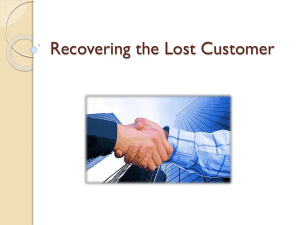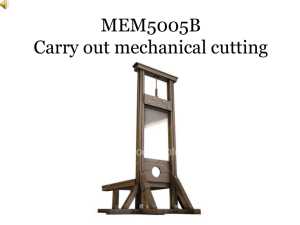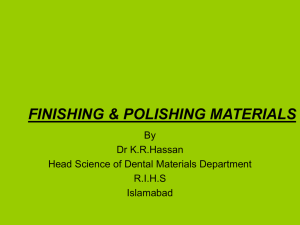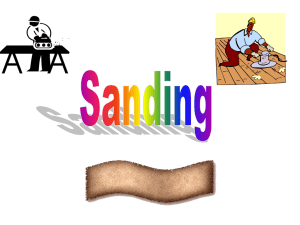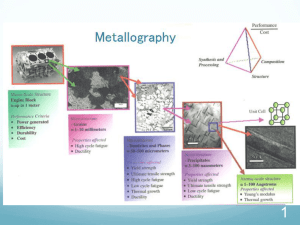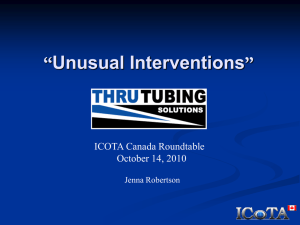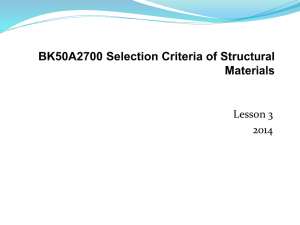Presentation_Slides
advertisement
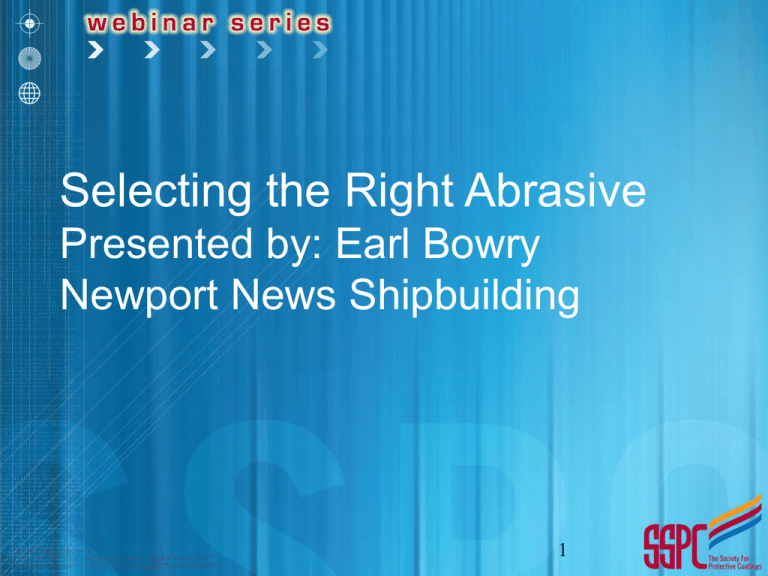
Selecting the Right Abrasive Presented by: Earl Bowry Newport News Shipbuilding 1 Learning Outcomes • At the end of this webinar, you will be able to: – Define types of abrasive – Recognize industry standards for different types of abrasives – Define abrasive characteristics and how they effect abrasive selection and productivity per specific job 2 3 Abrasive Types – Major Categories • Non-metallic – – – – Mineral Slag Organic Manufactured • Metallic – Steel grit – Steel shot – Iron grit 4 Mineral Abrasives • Mined or quarried, naturally-occurring: – Garnet – Olivine – Staurolite – Silica Sand 5 Mineral Abrasives • Hard and brittle • Fracture on impact, generating high dust levels • Dust generation and abrasive breakdown at elevated nozzle pressures is a potential problem 6 Organic Abrasives • Organic by-products such as: – Walnut shells – Corn cobs – Peach pits 7 Organic Abrasives • Used to remove lightly adhering coatings without damaging the substrate • Do not usually impart a surface profile 8 Walnut Shells Corn Cob 9 Manufactured Abrasives • • • • • • • Aluminum oxide Baking soda Ground cullet (glass) Silicon carbide Plastic pellets Dry ice Sponge jet 10 Manufactured Abrasives • Generally more costly than natural or byproduct abrasives • Used primarily for specialized applications in which a particular surface finish is required that justifies the extra cost 11 12 By-Product Abrasives • Slags: – Coal – Smelter • Copper • Nickel 13 By-Product Slag Abrasives, cont. • Slags: – By-products • Composition varies, depends on source – A form of glass • Fracture into sharp, angular particles • Widely used substitute for sand 14 By-Product Slag Abrasives, cont. • Slags: – Dust generation and abrasive breakdown at elevated nozzle pressures is a potential problem 15 16 Metallic Abrasives • Steel shot – round • Iron or steel grit – angular or irregular • Used extensively in the blast cleaning industry for the removal of paint, rust, mill scale and other surface contaminants from steel surfaces prior to painting • Must be dry – will rust if wet • Can be recycled many times in a dry environment 17 Metallic Abrasives, cont. • Brass, aluminum, and zinc abrasives are used primarily for specialized applications not related to paint and rust removal 18 19 Selecting Appropriate Abrasive • Type of abrasive selected influences: – Appearance of blast-cleaned surface – Productivity – Subsequent clean up 20 Abrasive Specifications • • • • SSPC-AB 1 SSPC-AB 2 SSPC-AB 3 SSPC-AB 4 21 Abrasive Specifications, cont. • SSPC-AB 1: – Defines requirements and references test methods for selecting and evaluating mineral and slag abrasives 22 Abrasive Specifications, cont. • SSPC-AB 2: – Defines requirements and references methods for testing cleanliness of recycled ferrous metallic abrasives 23 Abrasive Specifications, cont. • SSPC-AB 3: – Defines requirements for testing ferrous metallic (iron and steel) abrasives 24 Abrasive Specifications, cont. • SSPC-AB 4 – Defines requirements for selecting and evaluating abrasive media encapsulated in a compressible non-uniform cellular matrix 25 Abrasive Characteristics • • • • • • Hardness Size Shape Bulk density Friability/waste generation Recyclability 26 Hardness • Harder abrasives: – Tend to cut or etch the surface – May break down faster, creating more dust and embedment of abrasive into the surface • Softer abrasives: – Tend to polish the surface 27 Hardness, cont. • Metallic abrasive hardness: – Measured on the Rockwell C scale • Nonmetallic abrasive hardness: – Measured on the Mohs scale 28 Typical Hardness of Iron and Steel Abrasive • Steel shot – 40-50 Rockwell C • Steel grit – 55-60 Rockwell C • Iron grit – 55-60 Rockwell C 29 Comparative Abrasive Hardness Abrasive Hardness (Mohs) Silicon Carbide Aluminum Oxide Garnet Copper Slag Nickel Slag Coal Slag Ferric Oxide Flint Glass Beads Nut Shells Plastic Grit Corn Cobs 9.0 8.0-9.0+ 7.0-8.0 7.0-7.5 7.0-7.5 7.0-7.5 6.5-7.0 6.5-7.0 5.0-6.0 3.0-3.5 3.0-4.0 2.0-4.5 30 Size of Abrasive • Affects profile •Affects number of impacts per pound of abrasive Shape of Abrasive, cont. Spherical to round particles clean by impact, producing a peened surface • Angular to irregular shaped particles clean by scouring or cutting the surface, producing an etched or sharply angular surface • Shape of Abrasive, cont. In general, angular abrasives work well for removing heavy layers of paint and corrosion • More rounded abrasives work well for removing mill scale and lighter corrosion • Bulk Density • Bulk density: – A measure of an abrasive’s weight per unit volume – Usually expressed in pounds per cubic foot • Sand weighs approximately 100 lb/ft3 • Coal slag weighs approximately 90 lb/ft3 • Steel grit abrasives weighs approximately 250-280 lb/ft3 • Affects energy of each particle 34 Friability/Waste Generation • Friability: – A measure of an abrasive's resistance to breakdown on impact – Affects recycling – Affects amount of dust • The more friable an abrasive, the greater the tendency for the abrasive to breakdown on impact, generating more waste and dust 35 Friability/Waste Generation, cont. • Most mineral and byproduct abrasives can be recycled a limited number (1-3) of times • Steel abrasives, on the other hand show the lowest friability, generate the least amount of waste, and can be recycled many times 36 Friability/Waste Generation, cont. • Harder, less friable, recyclable abrasive, such as garnet and steel, tends to embed more when blasted dead on • Changing the blasting angle to 60° or less and sweeping the surface as you would in a brush off blast can reduce embedment while increasing productivity 37 Recyclability Iron and steel abrasive can be recycled several hundred times • Garnet can be recycled a few times • Mineral and slag abrasives are not normally recycled • Recyclability, cont. • SSPC-AB 2: – Describes cleanliness requirements for recycled iron and steel abrasives 39 SSPC AB-2 • Covers the requirements for cleanliness of recycled ferrous blast cleaning abrasives • Three representative samples collected at three different times during each reclamation cycle, or during an 8 hour period 40 Recyclability, cont. • Section 6 of the SSPC/NACE Blast Cleaning Standards (e.g., SP-10) require both recyclable and expendable abrasive to be clean, dry, and free of oil, grease, and other contaminants as determined by the test methods found in SSPC-AB 1, AB 2, AB 3 and AB 4 41 Surface Profile • • • • Important for adhesion Definition Factors that affect profile depth Measurement methods 42 Surface Profile, cont. • The facility owner specifies profile based on coating manufacturer recommendations • The profile to be specified depends on the generic coating type and the dry film thickness of the coating 43 Factors That Affect Profile Depth • • • • • Abrasive size Abrasive type Abrasive hardness psi (air pressure) at the nozzle Nozzle to surface distance 44 Factors That Affect Profile Depth, cont. • It is good practice to conduct trials before getting started to see what size and type of abrasive as well as what air pressure at the nozzle and distance and angle of attack are required to meet the specification • It is poor practice to create a profile deeper than specified and then re-blast to knock down the profile to get the required profile depth. This practice is very inefficient in that it not only increases costly rework but it also decreases the quality of the original surface profile 45 Factors That Affect Profile Depth, cont. • Profile ranges are stated by the coating manufacturer or facility owner for a purpose: to obtain maximum adhesion or bonding of the coating to the steel • When possible, consult your abrasive or blast machine equipment supplier’s technical representative for advice on abrasive size, type, and hardness, blasting pressure, cleaning angle, nozzle size, and distance from the surface in order to get the best quality job done at the lowest price 46 Productivity • Productivity is important because it can save time and often that translates into money savings for the contractor 48 Productivity, cont. • Abrasive characteristics and their influence on production are summarized here: – – – – – – Particle size Hardness Shape Bulk density Nozzle pressure Nozzle type 49 Productivity, cont. • Particle size: – Decreasing abrasive particle size can dramatically increase cleaning rate because more particles are impacting the surface per unit time compared to a coarser abrasive – Increasing abrasive size may be necessary to remove heavy coatings and scale – The general rule is to use the smallest size abrasive that will do the job 50 Productivity, cont. • Hardness: – In general, the harder an abrasive, the better it will perform on difficult to clean areas. However, very hard abrasives may shatter on impact expending most of the energy in particle disintegration and dust generation – Along with selecting the smallest abrasive size possible, the general rule here is to select the minimum abrasive hardness that will effectively do the job. Softer metallic abrasives can be recycled more times than harder metallic abrasives 51 Productivity, cont. • Shape: – Rounded abrasive particles produce a peened surface – An angular to irregular shaped abrasive particle produces an etched or more sharply defined surface – The right shape for the job at hand can have an impact on productivity and quality of surface profile 52 Productivity, cont. • Bulk density: – The higher the abrasive bulk density the more energy it will impart to the surface and thus do more work 53 Productivity, cont. • Cleanliness: – A clean, dry, dust free abrasive is essential for optimum productivity – Check the abrasive for foreign matter, moisture and dust before starting the job 54 Summary • The type of abrasive chosen influences the surface profile, appearance and productivity of the surface. The proper abrasive selection is based on the hardness, size, shape, bulk density, friability and recyclability of the abrasive 55

